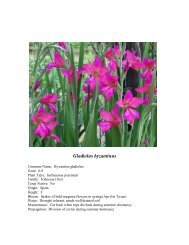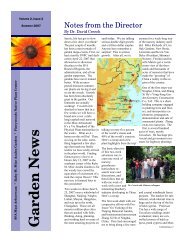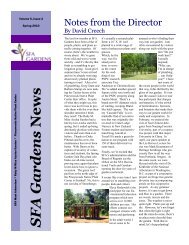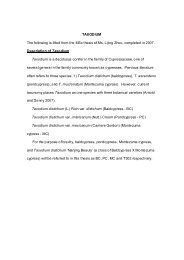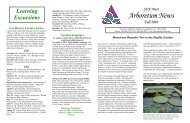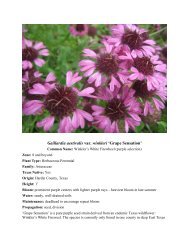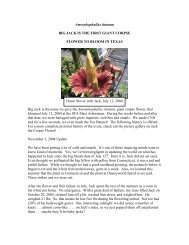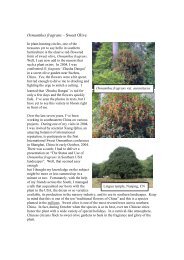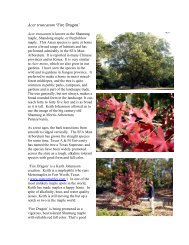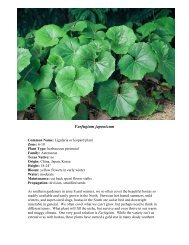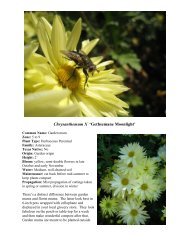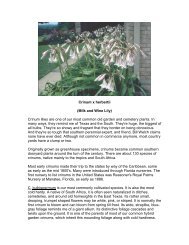native plants primer - SFA Gardens - Stephen F. Austin State ...
native plants primer - SFA Gardens - Stephen F. Austin State ...
native plants primer - SFA Gardens - Stephen F. Austin State ...
You also want an ePaper? Increase the reach of your titles
YUMPU automatically turns print PDFs into web optimized ePapers that Google loves.
expense should be spared to retrieve exotic <strong>plants</strong> from faraway places. The natural beauty of local<br />
<strong>plants</strong> was ignored.<br />
First, what is a <strong>native</strong> plant and what is an exotic? Classically, an exotic plant is one that does<br />
not have its normal range (provenance) in the area that it is being grown and sold. A <strong>native</strong> is one that<br />
occurs “naturally” in the region. Yet, many think of a <strong>native</strong> as “<strong>native</strong> to the U.S.” or “<strong>native</strong> to the<br />
state.” Thus a New York <strong>native</strong> plant grown in Texas might be considered a <strong>native</strong> or it might not; it<br />
would depend on whom you ask. Thus, Salvia greggii, <strong>native</strong> to the western portion of Texas might be<br />
considered a <strong>native</strong> when grown in East Texas . . . but is it really? Or, how about Itea virginica, the<br />
Virginia sweetspire, <strong>native</strong> to the wetlands of East Texas? It wouldn’t have a prayer in <strong>Austin</strong>, Texas,<br />
where calcareous soils and hot, dry conditions would spell out its doom. So, first define <strong>native</strong> as you<br />
want and then proceed.<br />
Some of the arguments preached for greater use of <strong>native</strong> <strong>plants</strong>:<br />
1. Natives are more disease and insect resistant. Not always. Some <strong>native</strong>s are quite easily<br />
attacked, disfigured, and even killed outright by indigenous pests. Dogwoods are an example. They<br />
are quite susceptible to stress and disease-related short life problems. A midge often disfigures<br />
yaupon foliage. Tent caterpillars can make a mess on oaks and pecans. Ask a catalpa what it thinks of<br />
the catalpa worm! There are hundreds of examples of diseases and insects that wreak havoc on<br />
<strong>native</strong>s.<br />
2. Natives are more drought resistant. This argument carries little weight unless the species is<br />
one that normally grows in dry climates and is adapted to dry soils. A <strong>native</strong> plant that normally finds its<br />
home in a swamp or stream-side may perform admirably in a drier site, but that’s not always the case.<br />
3. Natives are less invasive. Of course, in some cases that’s true. Some <strong>native</strong>s, however,<br />
are not quite so docile. In our region of Texas, seedlings of oaks and redbuds can sprout up in the<br />
thousands, making for a ubiquitous problem in the landscape. Some <strong>native</strong>s, on the other hand, are<br />
quite well behaved – offering up few seed or demanding seedling conditions difficult to duplicate in the<br />
landscape.<br />
4. Natives reflect the “natural” flora of a region. Well, of course, that’s true. Whether that’s the<br />
catchall, be-all is another question. There are also harmony, continuity, and balance-with-nature issues<br />
that drive the argument here. Ecological sensitivity. Environmental prudence.<br />
On the other side of the issue (exotics are good), the following arguments are often offered.<br />
1. Exotics are often very well adapted, trouble-free, and most present no invasive issues of any<br />
substance. No doubt about it: Plants from China, Japan and Korea make up a large sector of the<br />
nursery industry’s offerings in the U.S. Many of them have been here for over a hundred years with<br />
little invasiveness. Why are so many flowering shrubs from Asia sold in the U.S.? Well, for one<br />
reason, hardiness zones and climatic conditions in Asia can be found in regions there that closely<br />
imitate many locations in the U.S.<br />
2. Exotics are more floriferous, beautiful, and showier than most <strong>native</strong>s. Well, few would<br />
argue that many of the most colorful landscape <strong>plants</strong> in use today in the South can trace their origins<br />
back to Asia and there continues to be great excitement in new <strong>plants</strong> coming out of China, Japan and<br />
Korea today.<br />
3. Exotics can be durable, low-maintenance and drought tolerant. Of course that’s true. For<br />
example, one of the toughest exotic small trees gaining popularity in the South today is Chionanthus<br />
retusus, the Chinese fringe tree (a counterpart species to our very own <strong>native</strong>, C. virginicus, the <strong>native</strong>



